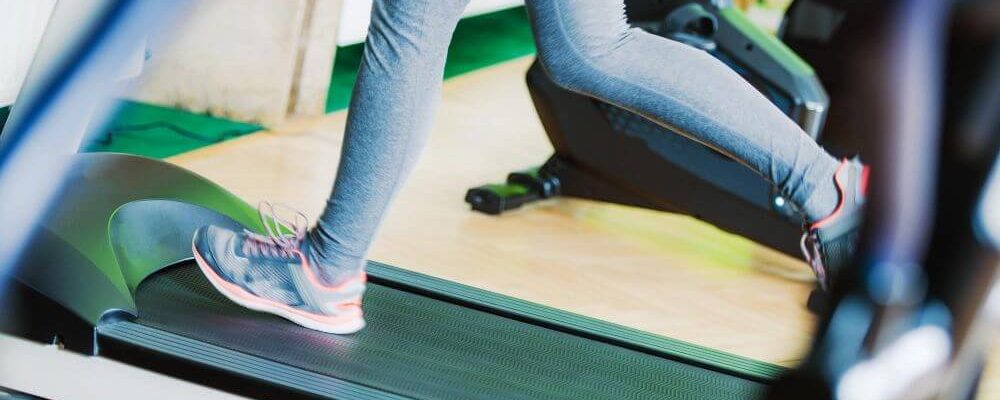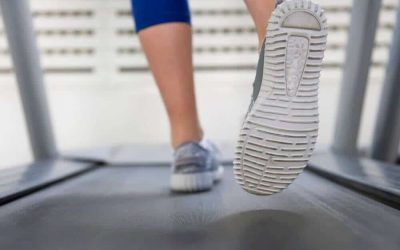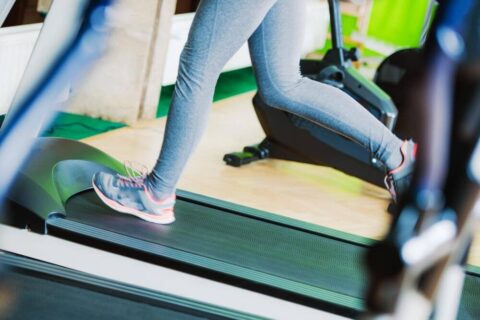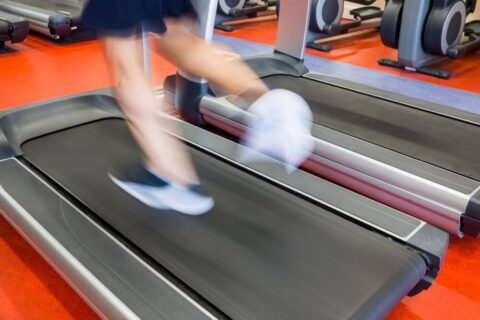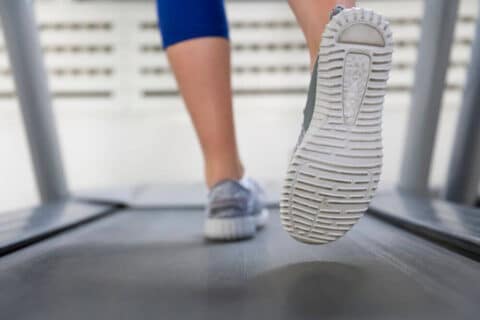What is Treadmill Incline?
A treadmill incline is an adjustable feature that allows you to raise the running surface to simulate uphill terrain. With the push of a button, you can increase or decrease the incline level, making your workout more challenging and engaging.
When using a treadmill with an incline, you can adjust the angle of the running surface. This can help you target different muscle groups, increase the intensity of your workout, and burn more calories. Walking or running on an incline engages your glutes, hamstrings, and calves to a greater extent than exercising on a flat surface.
This added challenge can also improve your cardiovascular fitness and endurance. Whether you’re training for a race, looking to lose weight, or simply wanting to add variety to your workouts, the treadmill incline feature can help you achieve your goals.
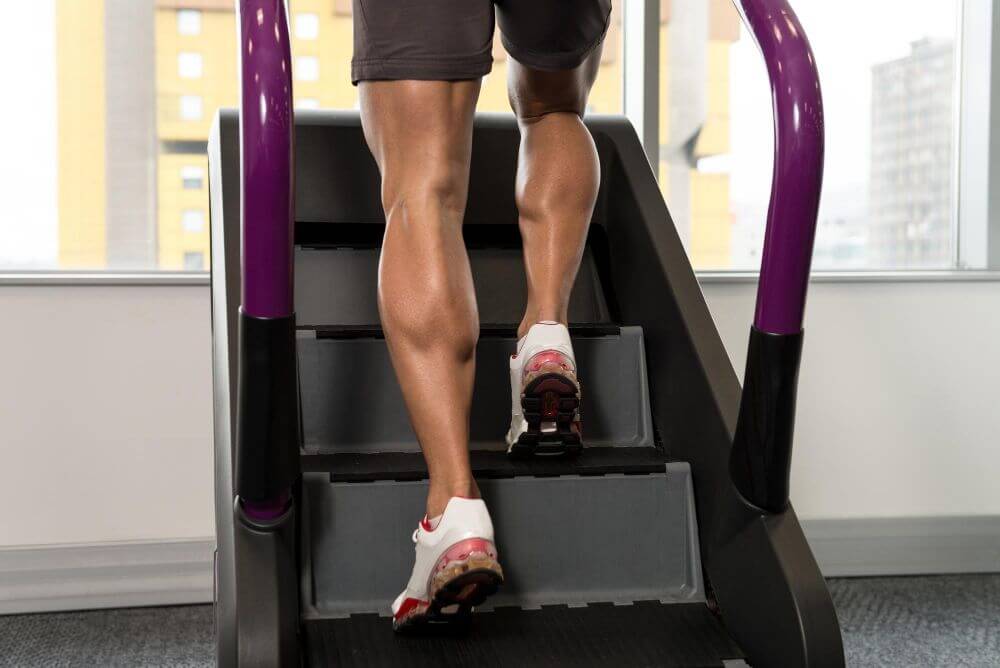
Contents
The Benefits of Treadmill Incline
Treadmill incline offers numerous benefits, such as increased calorie burn, improved cardiovascular endurance, and strengthened lower body muscles. By adjusting the incline, you can simulate uphill running and challenge your fitness levels effectively.
When it comes to effective cardio workouts, treadmills are a popular choice. One feature that sets them apart is the ability to adjust the incline. Raising the running surface allows you to simulate uphill runs, which offers numerous benefits for your fitness journey.
Let’s explore how incorporating treadmill incline into your workouts can enhance cardiovascular endurance, muscle activation, and calorie burn.
How Incline Training Improves Cardiovascular Endurance:
- Boosts cardiovascular fitness: Running or walking on an inclined treadmill requires more effort from your heart and lungs, effectively improving your cardiovascular endurance.
- Increases oxygen consumption: The uphill challenge of incline training forces your body to work harder, increasing oxygen uptake and utilization.
- Enhances energy efficiency: Regular incline workouts can train your body to become more efficient at using energy, making your overall cardio performance more efficient during flat-surface runs.
The Impact Of Treadmill Incline On Muscle Activation:
- Targets the leg muscles: Uphill running activates your lower body muscles, including the quadriceps, hamstrings, calves, and glutes, improving strength and tone.
- Engages core muscles: When incline training, your core muscles work harder to maintain stability and balance, leading to a stronger and more engaged core.
- Balances muscle development: Incline training provides a diverse stimulus for muscles, promoting balanced development throughout your legs and core.
Burning More Calories With Incline Workouts:
- Increased calorie expenditure: Running or walking uphill requires additional effort, burning more calories than workouts on a flat surface.
- Boosts metabolic rate: Incline training stimulates your metabolism, leading to an elevated calorie burn even after completing your workout.
- Interval training option: Incline workouts lend themselves well to high-intensity interval training (HIIT). Alternating between periods of intense uphill running and active recovery promotes calorie burn and fat loss.
By incorporating treadmill incline into your fitness routine, you can experience these benefits and take your workouts to new heights. Challenge yourself with varied incline levels and intensities, and watch your cardiovascular endurance, muscle strength, and calorie burn soar. Take advantage of this versatile feature and maximize the effectiveness of your treadmill workouts!
Exploring Different Incline Settings
Treadmill incline refers to the adjustable slope set on a treadmill. It allows users to simulate walking or running uphill, adding a challenge to their workout and targeting different muscle groups. Explore various incline settings to enhance your treadmill workout experience.
Understanding The Incline Percentage And Its Effects
Understanding the incline settings is crucial for optimizing your treadmill workout. The incline percentage refers to the steepness of the treadmill, which can be adjusted to simulate uphill or downhill running. By changing the incline, you can target different muscle groups, increase the intensity of your training, and achieve various fitness goals.
Here are some key points to help you understand the incline percentage and its effects:
- The incline percentage indicates the rise of the treadmill deck. For example, an incline of 5% means the deck is elevated by 5 units per 100 units of length.
- Increasing the incline percentage engages more muscles in your lower body, particularly the glutes, hamstrings, and calves.
- Running or walking on an inclined surface can burn more calories than exercising on a flat surface.
- Incline training adds an extra challenge to your cardio workout, making it more demanding and effective for improving endurance.
- The higher the incline, the more impact it has on your joints, so it’s important to gradually increase the incline if you’re new to incline training or have joint issues.
- Running or walking downhill on a treadmill can help muscle recovery and be a low-impact option for people with certain injuries.

Adjusting The Incline For Different Training Goals
One of the great benefits of treadmills is the ability to customize your workout by adjusting the incline. Here are some ways you can modify the incline based on your training goals:
- Fat burning and weight loss: Increasing the incline to a moderate level (around 5-8%) can help you burn more calories and fat by increasing the intensity of your workout.
- Endurance training: Try incorporating high-incline intervals into your routine to improve your cardiovascular fitness and stamina. Alternate between lower inclines (around 2-4%) and higher inclines (around 8-10%) for a challenging workout.
- Hill training: Mimic the experience of running or walking uphill by setting a steeper incline (around 10-15%). This type of training is beneficial for building leg strength, speed, and power.
- Rehabilitation and joint-friendly workouts: If you’re recovering from an injury or prefer low-impact exercises, choose a lower incline (around 1-3%) or even a slight decline to reduce joint stress while still getting a good workout.
Customizing Your Workout With Automatic Incline Adjustments
Many modern treadmills come with automatic incline adjustments, making your workout more dynamic and engaging. Here’s how you can customize your workout using this feature:
- Pre-set workout programs: Treadmills often have pre-set workout programs that automatically adjust the incline to simulate different terrains or training regimens. These programs can add variety to your workouts and achieve specific goals.
- Manual adjustments: You can manually adjust the incline during your workout based on your feelings or the specific training session you have planned. Increase or decrease the incline gradually to challenge yourself or give your body a break.
- Incline intervals: Incorporate incline intervals into your workout routine by alternating between periods of flat running or walking and periods of increased incline. This training helps improve your fitness levels and keeps your workouts interesting.
Understanding and utilizing the incline settings on a treadmill can greatly enhance the effectiveness of your workouts. Whether targeting specific muscle groups, trying to burn more calories, or improving your endurance, adjusting the incline is a valuable tool to achieve your fitness goals.
Experiment with different incline percentages and adjust automatically to make your treadmill workouts more challenging and enjoyable.
Best Practices For Incorporating Incline Workouts
Treadmill incline workouts are a great way to challenge your body and increase the intensity of your treadmill sessions. By incorporating incline work, you can target different muscle groups, boost calorie burning, and simulate outdoor terrain for a more varied workout experience.
Incorporating incline workouts into your treadmill routine can add a new level of challenge and effectiveness to your training. By adjusting the treadmill’s incline, you can simulate uphill running or hiking, which helps to engage different muscle groups and increase the intensity of your workout.
Here are some best practices for incorporating incline workouts into your fitness routine:
Gradually Increasing Incline For Safe And Effective Training:
- Begin with a warm-up: Start your workout with a flat surface and gradually increase the speed before adding any incline. This will help warm up your muscles and prepare them for the increased intensity.
- Start small: If you’re new to incline workouts, start with a modest incline of around 3-5%. As you get comfortable, gradually increase the incline to challenge yourself further.
- Listen to your body: Pay attention to how your body feels during the workout. Lower the incline or take a break if you experience any pain or discomfort. It’s important to prioritize safety and avoid overexertion.
Combining Incline Intervals With Speed Variations:
- Intervals: Incorporating intervals into your incline workouts can add excitement and intensity. Alternate between periods of higher incline and lower incline or flat surfaces. This can help improve your cardiovascular fitness and boost your calorie burn.
- Vary your speed: Experiment with different speeds while incorporating incline intervals. Mix up your pace, going faster during flat or lower incline sections and slowing down during higher incline sections. This variation helps to target different muscle fibers and keeps your workout engaging.
Incorporating Strength Exercises With Incline Training:
- Core exercises: Utilize the incline to perform core strengthening exercises like mountain climbers, planks, or incline push-ups. The added challenge of an incline will intensify these exercises and engage your core muscles even more.
- Walking lunges: Incorporate walking lunges on an incline to target your glutes, quadriceps, and hamstrings. This exercise adds resistance to your lower-body muscles and helps to build strength and endurance.
- Step-ups: Utilize an incline to perform step-ups, alternating your leading leg. This exercise targets your quads, glutes, and calves, giving you a powerful lower-body workout.
Incorporating incline workouts into your treadmill routine can provide numerous benefits, from increased calorie burn and cardiovascular fitness to building strength and toning muscles. Remember to always listen to your body and gradually build up the intensity. By incorporating these best practices, you can make the most out of your treadmill incline workouts.

Using Incline Training For Specific Fitness Goals
Treadmill incline training is a useful tool to achieve specific fitness goals. Whether you want to build strength, increase endurance, or burn calories, adjusting the incline can help you tailor your workouts to your individual needs.
Maximizing Fat Burning And Weight Loss With Incline Workouts:
Incorporating incline training into your treadmill routine can be a game-changer for those looking to burn fat and shed those extra pounds. Here’s how:
- Increased calorie burn: Adjusting the incline can intensify your workout and maximize calorie expenditure. Incline training forces your muscles to work harder, thus increasing your metabolic rate.
- Activating leg and core muscles: Walking or running on an incline engages more muscle groups, including your quadriceps, hamstrings, glutes, and core. This leads to improved muscle tone and definition.
- Better cardiovascular challenge: Incline workouts elevate your heart rate, delivering a more intense cardiovascular workout. This helps to improve cardiovascular health and endurance.
Building Strength And Endurance For Outdoor Hill Running:
Incline training can be valuable for runners aiming to conquer hills during outdoor runs. Here’s how it can help:
- Strengthening leg muscles: Running on an incline targets your lower body muscles, including your calves, quadriceps, hamstrings, and glutes. This builds strength and power, enabling you to easily tackle uphill climbs.
- Mimicking outdoor terrain: Incline training on a treadmill replicates the challenge of running on hilly terrain, helping you prepare for outdoor runs on uneven surfaces.
- Endurance development: Regular incline workouts gradually increase your stamina, allowing you to sustain a higher intensity for a longer duration. This, in turn, enhances your overall running performance.
Improving Overall Athletic Performance Through Incline Training:
Incline training is not limited to runners; it benefits athletes across various sports. Here’s how it can boost your athletic performance:
- Increased power output: Incline workouts stimulate muscle growth and improve power, enhancing performance in explosive movements and high-intensity activities.
- Enhanced balance and stability: The constant adjustments to balance on an incline engage your core and stabilizer muscles, improving balance and stability during sports movements.
- Improved stride length and speed: Incline training strengthens your leg muscles, enabling you to generate more force and exhibit a longer stride length. This results in improved speed on both the treadmill and outdoor tracks.
You can target specific fitness goals using incline training: burning fat and losing weight, building strength and endurance for outdoor runs, or enhancing your overall athletic performance. Incorporate incline workouts into your exercise routine and witness the transformative effects on your fitness journey.
What is Treadmill Incline? Treadmill Incline Vs. Outdoor Terrain
The treadmill incline allows you to simulate outdoor terrain by adjusting the angle of the running surface.
Treadmill incline and outdoor terrain provide different experiences and challenges for runners. Whether you prefer the convenience and controlled environment of the treadmill or the natural variations of outdoor running, each option has its own benefits and drawbacks.
This section will compare the advantages and disadvantages of treadmill incline and outdoor hill running. We will also explore how treadmill incline can help simulate real-world training conditions and discuss how to use incline workouts to supplement your outdoor runs.
Comparing The Benefits And Drawbacks Of Treadmill Incline And Outdoor Hill Running:
- Treadmill Incline:
- Mimics outdoor running conditions by simulating hills.
- Allows precise control over incline settings.
- Offers a consistent and predictable workout surface.
- Can be adjusted to match your fitness level and training goals.
- Provides easy access to interval training and varied workout intensities.
- Outdoor Terrain:
- Challenges your body with natural variations in elevation.
- Engages different muscles, including stabilizing muscles.
- Offers a more visually appealing and engaging workout experience.
- Provides fresh air and the opportunity to explore different routes.
- Enhances mental stimulation with changing scenery and external factors.
How Treadmill Incline Can Simulate Real-world Training Conditions:
Mimicking Hills:
- Treadmills with incline settings allow you to replicate the experience of running uphill, optimizing your training routine.
- By increasing the incline, you engage more muscles, promote better running form, and improve your cardiovascular endurance.
Controlled Environment:
- Treadmill incline enables consistent and controlled hill training, regardless of weather conditions or geographical limitations.
- It allows you to work on your pacing and endurance without worrying about external factors like wind resistance or unforgiving terrains.
Using Incline Workouts To Supplement Outdoor Runs:
Strengthening Muscles:
- Incorporating treadmill incline workouts into your training routine can help you build strength in the specific muscles used for uphill running.
- This targeted conditioning can enhance your overall performance during outdoor hill runs.
Injury Prevention:
- Incline training offers a lower-impact alternative to repetitive downhill workouts, reducing the risk of joint strain and impact-related injuries associated with outdoor hill running.
- By gradually increasing the incline, you can build endurance and strength while minimizing the potential for injuries.
By understanding the benefits and drawbacks of treadmill incline and outdoor terrain, you can choose the approach that best suits your goals and preferences. Whether you embrace the controlled environment of the treadmill or thrive off the challenges presented by outdoor hill running, both options have unique advantages.
Remember to leverage the treadmill incline to simulate real-world training conditions and use incline workouts to supplement your outdoor runs, ultimately enhancing your overall running performance.

Tips For Proper Form And Technique On Inclined Treadmill
Treadmill incline refers to the angle at which the treadmill is elevated. Following proper form and technique on an inclined treadmill is essential to maximize the benefits of your workout and avoid injury. Here are some tips to help you maintain the right form and technique on an inclined treadmill.
Maintaining proper posture and alignment during incline workouts:
- Stand tall with your shoulders relaxed and your spine in a neutral position.
- Engage your core muscles by gently pulling your belly button towards your spine.
- Avoid leaning too far forward or backward, as this can strain your back and affect your balance.
- Keep your eyes focused straight ahead, not looking down at your feet or the television screen.
- Maintain a natural arm swing with your elbows bent at a 90-degree angle.
The importance of engaging core muscles on an inclined treadmill:
- Your core muscles are vital in providing stability and support during incline workouts.
- Engaging your core helps to maintain proper alignment and prevent excessive strain on your back.
- You can also enhance your overall balance and coordination on the treadmill by activating your core.
- Focus on tightening your abdominal muscles and maintaining a strong, stable core throughout your workout.
Utilizing handrails and balance techniques for stability:
- While avoiding relying too heavily on the handrails is important, they can provide extra stability, especially when adjusting to an incline.
- Lightly rest your fingertips on the handrails to assist with balance, but gradually reduce reliance as your comfort level increases.
- Practice a wider stance on the treadmill to create a more stable support base.
- Keep your feet centered on the belt and avoid stepping too far forward or backward.
- Concentrate on maintaining a steady and controlled pace to maintain your balance.
Remember, proper form and technique are essential for maximizing the benefits of your inclined treadmill workouts. By following these tips, you can ensure that you perform your exercises safely and effectively, promoting a healthy and enjoyable fitness routine.
Frequently Asked Questions
What Is A Good Incline For A Treadmill?
A good incline for a treadmill depends on your fitness goals and preferences. Gradually increasing the incline can help stimulate outdoor running and improve muscle activation. For general fitness, a 1-2% incline is sufficient. If you want to target specific muscles or increase the intensity, you can reach a 5-8% incline.
High-intensity interval training (HIIT) may involve alternating between flat and steep inclines, like 10-15%. Remember to listen to your body and start with a comfortable incline. Adjust it as needed to challenge yourself and avoid overexertion. It’s always a good idea to consult a fitness professional or trainer to determine the best incline for your specific needs.
What Does 1 Incline Mean On Treadmill?
A treadmill with 1 incline means that the running surface is elevated by 1 unit. This feature allows you to simulate running or walking uphill. Incline settings on treadmills usually range from 0 to 15 or more, with higher numbers indicating steeper inclines.
Increasing the incline can intensify your workout and engage different muscle groups. It provides a greater challenge and can help increase cardiovascular endurance and burn more calories. You can adjust the incline manually or choose preset programs that automatically vary the incline during your workout.
It’s important to note that incline settings may vary among different treadmill models, so always refer to the specific instructions for your machine.
What Does 2 Incline On Treadmill Mean?
2 incline on a treadmill means that the treadmill deck is positioned at a 2% incline from a horizontal level. This means that the front of the treadmill is slightly higher than the back, creating a gentle slope. The incline feature is commonly found on treadmills and allows users to simulate walking or running on an uphill terrain.
It adds intensity to the workout, engaging different muscles and increasing calorie burn. The incline level can usually be adjusted, with higher numbers indicating a steeper incline. By incorporating incline training into your treadmill workouts, you can target specific muscle groups, challenge your cardiovascular system, and diversify your exercise routine.
Is 12 Incline Good On Treadmill?
A 12 incline on a treadmill is considered good for a challenging workout. It helps to increase the intensity and engage different muscle groups, such as the glutes, hamstrings, and calves. With a higher incline, you can burn more calories and improve your cardiovascular endurance.
However, it is important to listen to your body and start at a lower incline if you are a beginner. Gradually increase the incline as you get stronger and more comfortable. Remember to maintain proper form and posture while using an incline, as it may put more strain on your joints.
Using a 12-incline can benefit interval training or simulating hill climbs. Always consult a fitness professional or your doctor before starting any new exercise routine, especially if you have health concerns.
Final Words: What is Treadmill Incline
Incorporating treadmill incline into your workouts can greatly enhance your overall fitness routine. Adjusting the incline increases the intensity and engagement of your muscles, leading to more effective calorie burning and improved cardiovascular health. Additionally, using incline on a treadmill can help mimic the outdoor running experience, providing a more varied and challenging workout.
It is important to note that increasing the incline also puts more stress on your joints and muscles, so it is crucial to build up gradually and listen to your body’s limits. Whether you are a beginner or an experienced runner, adding incline to your treadmill workouts can elevate your fitness goals.
So next time you hit the gym, try the treadmill incline feature and watch as your fitness levels soar.

